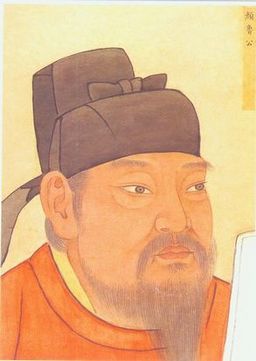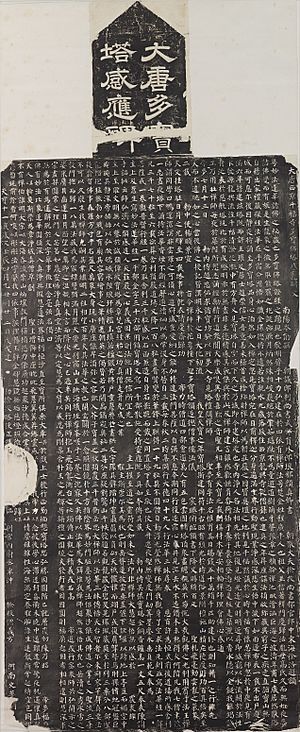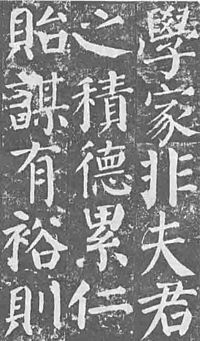Yan Zhenqing facts for kids
 |
|
| Other Names | |
|---|---|
| Courtesy Name: | Qingchen (清臣) |
| Alias: | Yan Pingyuan (顏平原) Yan Lugong (顏魯公) |
| Posthumous name: | Wenzhong (文忠) |
Yan Zhenqing (simplified Chinese: 颜真卿; traditional Chinese: 顏真卿; pinyin: Yán Zhēnqīng; Wade–Giles: Yen Chen-ch'ing; 709–785) was a famous Chinese calligrapher, military general, and government official. He was a leading expert in Chinese calligraphy and a very loyal governor during the Tang dynasty. His art in Chinese calligraphy is considered as great as the best masters in history. His special writing style, called Yan style, is still copied by many today.
Contents
Yan Zhenqing's Life Story
Growing Up and Early Career
Yan Zhenqing was born in Wannian (萬年), near the Tang capital city of Chang'an. He came from a well-known family of scholars who had worked for the government for many years. One of his ancestors was Yan Zhitui, a scholar and official. His great-great-grandfather, Yan Shigu, was a famous language expert. His father, Yan Weizhen (顏惟貞), taught the Tang princes and was also a great calligrapher. Because of his family and his mother, Lady Yin (殷氏), Yan Zhenqing studied hard from a young age. He read a lot about literature and Confucianism, which is a system of beliefs from ancient China.
In 734, when he was 22, Yan Zhenqing passed a tough national test called the imperial examination. This earned him the title of Jinshi, which was like getting a high-level degree today. He then took another special test for very talented people and did very well again. Because of his strong education, Yan Zhenqing quickly moved up in the government. He became a vice-magistrate, then an inspector, and later a censor in the palace. People liked him because he was honest and spoke his mind. However, the powerful Grand Councilor, Yang Guozhong, got angry with him. So, in 753, Yan Zhenqing was sent away from the capital to be the governor of Pingyuan Commandery.
Facing Civil War
When Yan Zhenqing became governor of Pingyuan, a big war called the An Shi Rebellion was about to start. Yan Zhenqing was smart and knew war was coming. He quickly started making the city walls stronger and storing food. He also sent urgent messages to Emperor Xuanzong, but the emperor did not listen.
In December 755, two generals, An Lushan and Shi Siming, started a rebellion. They said they wanted to remove Yang Guozhong from power. The Tang government's soldiers were not ready and quickly gave up many areas. Only Yan Zhenqing's Pingyuan held strong. He then joined forces with his cousin, Yan Gaoqing, who was the governor of Changshan. They fought the rebels from behind their lines. The government was desperate and made Yan Zhenqing a high-ranking official. They also gave him a lot of military power to help General Li Guangbi stop the rebellion.
Yan's forces won several important battles against the rebels. They cut off the rebels' supplies and took back control of seventeen areas. In 756, Emperor Suzong became the new emperor and promoted Yan Zhenqing. But because the Tang government made some bad military decisions, An Lushan suddenly attacked Hebei. Yan Zhenqing had to leave his command and returned to the capital in 757. He was then made Minister of Law. However, he kept speaking out against corrupt officials, which led to him being demoted and promoted many times.
Later Years and Legacy
In 764, Emperor Daizong gave Yan Zhenqing the title of Duke of Lu (魯公). This was to honor his strong loyalty to the government and his bravery during the An Lushan Rebellion. However, his firm character was disliked by the powerful Grand Councilor, Lu Qi. This dislike eventually cost Yan Zhenqing his life.
In 784, a military leader named Li Xilie started another rebellion. Lu Qi had held a grudge against Yan Zhenqing for a long time. So, he sent Yan Zhenqing to talk with Li Xilie, hoping Yan Zhenqing would be killed. As expected, Li Xilie tried everything to make Yan Zhenqing surrender, but Yan Zhenqing never gave in. It is said that Li Xilie even lit a fire and told Yan Zhenqing he would be burned if he did not surrender. But Yan Zhenqing showed no fear and walked towards the fire. Li Xilie was impressed by his courage. In 785, Yan Zhenqing was secretly killed at a temple in Caizhou, Henan.
When Emperor Daizong heard of his death, he closed the government for five days to mourn. He also gave Yan Zhenqing the special title Wenzhong (文忠). Many soldiers and people were sad about his death, and a temple was built to remember him. Later, in the Song dynasty, the temple was moved to Shandong and became a popular place for visitors.
Calligraphy Masterpiece
Yan Zhenqing is often seen as the only calligrapher who was as good as Wang Xizhi, known as the "calligraphy sage." Yan Zhenqing was especially good at the regular (kaishu 楷書) and cursive (caoshu 草書) styles. But he also mastered other ways of writing. His regular script style, often called Yan script (Yanti 顏體), brought new ideas to Chinese calligraphy. It showed strength, boldness, and a grand feeling. Like most great calligraphers, Yan Zhenqing learned from many teachers. His personal style developed in three main stages.
Early Learning Period
Most calligraphy experts agree that Yan Zhenqing's early period lasted until he was about fifty. During these years, he tried different ways of writing and began to create his own unique style. When he was young, he learned calligraphy from famous masters like Zhang Xu and Chu Suiliang. Zhang Xu was great at Cao Script, which focuses on the overall look and flow of the writing. Chu Suiliang was known for his elegant and refined Kai Script. Yan Zhenqing also got ideas from the Wei Bei (魏碑) Style. This style came from northern groups and was known for its strength and simplicity.
In 758, he wrote a very important calligraphy piece called Draft of a Requiem to My Nephew (祭姪文稿).
Developing His Unique Style
This period was when Yan Zhenqing was in his fifties and early sixties. During these years, he created famous works like Guojia Miao Stele (郭傢廟碑). After going through the An Lushan Rebellion and many ups and downs in his government job, Yan Zhenqing's writing style became more mature. He used more strength in his brush strokes. He also mixed techniques from the zhuan (篆) and li (隷) Scripts into his own style. This made the start and end of his brush lines softer.
For single strokes, he followed the rule of "thin horizontal and thick vertical strokes." The width of his strokes changed to show curves and flow. Dots and slanted strokes ended with sharp points. For the structure of each character, Yan's style looks square and well-arranged. The middle part is spacious, and the outer strokes are tight. This look is more like the older Zhuan and Li Scripts. When it comes to spacing, his characters are close together vertically, leaving more space between lines. So, the new Yan style was different from the fancy styles of earlier Tang calligraphers. It was upright, strong, balanced, rich, and controlled. It was a change from the earlier styles that were often slanted, delicate, pretty, thin, and unpredictable.
Peak of His Art
In the ten years before he died, Yan Zhenqing's calligraphy reached its best. His style was now fully formed, and he kept improving with each work. He finished his greatest work, the Yan Qinli Stele (顏勤禮碑). At this stage, he could show his style perfectly, even with just one stroke. His modest and grand style also showed a lot of life and passion. He also wrote A Poem to General Pei (裴將軍詩). This was groundbreaking for his time because it showed many different writing styles in the same piece.
Lasting Influence
Yan Zhenqing's style brought together the best parts of calligraphy from the past five hundred years. Almost every calligrapher after him was influenced by his work. During his time, another great calligrapher, Liu Gongquan, learned from him. Later, the respected Five-Dynasty Period calligrapher, Yang Ningshi (楊凝式), fully adopted Yan Zhenqing's style and made it even bolder.
Many calligraphers copied Yan Zhenqing's style during the Song dynasty. The "Four Grand Masters of the Song" – Su Shi, Huang Tingjian (黃庭堅), Mi Fu (米芾), and Cai Xiang – all studied the Yan Style. Su Shi even said that Yan Zhenqing's calligraphy was "peerless" (meaning, without equal) in all of history.
After the Song dynasty, Yan Zhenqing's popularity went down a little. Calligraphers started to use more abstract ways of expressing themselves. However, he still remained very important. Many famous calligraphers, like Zhao Mengfu (趙孟頫) and Dong Qichang (董 Qichang), were inspired by Yan Zhenqing.
In modern China, leading calligraphers like Sha Menghai (沙孟海) and Shen Yinmo have done a lot of research on the Yan style. This has made it popular again. Today, almost every Chinese calligraphy student starts by copying the Yan style when they first learn. Yan Zhenqing's influence has also spread to Korea, Japan, and Southeast Asia.
See also
- Tang dynasty art
- Tang dynasty
- An Shi Rebellion





